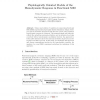Free Online Productivity Tools
i2Speak
i2Symbol
i2OCR
iTex2Img
iWeb2Print
iWeb2Shot
i2Type
iPdf2Split
iPdf2Merge
i2Bopomofo
i2Arabic
i2Style
i2Image
i2PDF
iLatex2Rtf
Sci2ools
122
click to vote
IPMI
1999
Springer
1999
Springer
Physiologically Oriented Models of the Hemodynamic Response in Functional MRI
Today, most studies of cognitive processes using functional MRI (fMRI) experiments adopt highly flexible stimulation designs, where not only the activation amount but also the time course of the measured hemodynamic response is of interest. The measured signal only indirectly reflects the underlying neuronal activation, and is understood as being convolved with a hemodynamic modulation function. An approach to better allow inferences about the neuronal activation is given by modeling this convolution process. In this study, we investigate this approach and discuss computational models for the hemodynamic response. An analysis of a recent fMRI experiment underlines the usefulness of this approach.
Hemodynamic Modulation Function | Hemodynamic Response | IPMI 1999 | Medical Imaging | Neuronal Activation |
Related Content
| Added | 04 Aug 2010 |
| Updated | 04 Aug 2010 |
| Type | Conference |
| Year | 1999 |
| Where | IPMI |
| Authors | Frithjof Kruggel, D. Yves von Cramon |
Comments (0)

